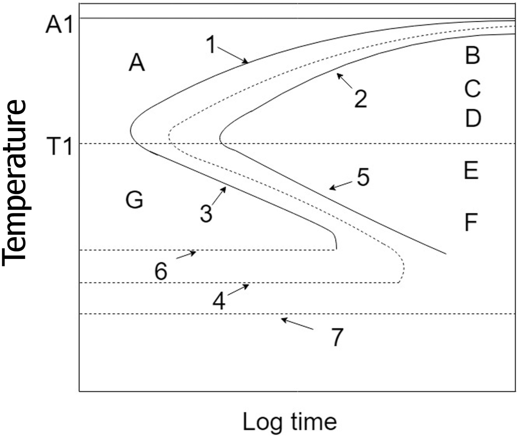This set of Heat Treatment of Metals and Alloys Multiple Choice Questions & Answers (MCQs) focuses on “Steels – Time Temperature Transformation Curves”.
1. The kinetics of austenite can be best understood at ____________
a) constant temperature
b) constant cooling rate
c) variable temperature
d) continuous cooling
View Answer
Explanation: The kinetics of austenite is studied at a constant temperature. That is why the time temperature transformation is also known as isothermal transformation.
2. Which one of the following statements is correct for the TTT diagram?
a) Davenport and Bain included Ms and Mf temperatures in the TTT diagram
b) Cohen was the first to develop TTT diagram
c) Cohen determined the pearlite and bainite portions in TTT diagram
d) Davenport and Bain were the first to develop TTT diagram
View Answer
Explanation: Davenport and Bain were the first to develop the TTT diagram. They did it first for eutectoid steel. They were the one who found out the pearlite and bainite positions. Cohen was the one to introduce Ms and Mf temperatures for martensite.
3. What is the most popular method of determining the TTT diagram?
a) Acoustic emission
b) Density measurement technique
c) Salt bath technique
d) Dilatometry
View Answer
Explanation: Salt bath techniques are the most popular method of determining the TTT diagram. Apart from this, there are other techniques like Acoustic emission, Density measurement technique, Dilatometry, etc.
4. In the given TTT diagram, what does curve 1 denote?

a) Pearlite start
b) Pearlite finish
c) Austenite finish
d) 50% pearlite
View Answer
Explanation: Curve 1 denotes the locus of different times at which pearlite formation starts at different temperatures. At this curve, pearlite starts to form in the matrix of austenite.
5. In the given TTT diagram, what do regions B, C, D represent respectively?

a) Fine pearlite, medium pearlite, coarse pearlite
b) Medium pearlite, coarse pearlite, fine pearlite
c) Coarse pearlite, medium pearlite, fine pearlite
d) Coarse pearlite, fine pearlite, medium pearlite
View Answer
Explanation: Regions B, C, D represent coarse pearlite, medium pearlite and fine pearlite respectively. As the temperature decreases, the grain size decreases. Finer the grain size, harder will be the structure.
6. In the given TTT diagram, what do regions E and F denote respectively?

a) Upper bainite, lower bainite
b) Fine martensite, coarse martensite
c) Coarse martensite, fine martensite
d) Lower bainite, upper bainite
View Answer
Explanation: Regions E and F denote upper bainite and lower bainite respectively. Lower bainite has higher hardness than upper bainite.
7. In the given TTT diagram, what does T1 denote?

a) Martensite start temperature
b) Martensite finish temperature
c) Nose temperature
d) Austenite temperature
View Answer
Explanation: T1 temperature is the nose temperature. If we draw a tangent at the nose of the curve, it will give us the critical cooling rate. At this point, very fine pearlite forms.
8. In the given TTT diagram, what does region G denote?

a) Martensite
b) Pearlite
c) Bainite
d) Metastable austenite
View Answer
Explanation: Region G denotes metastable austenite. After region G, martensite formation starts. At this region austenite is in metastable state.
9. In the given TTT diagram, what does curve 3 denote?

a) Martensite start
b) Martensite finish
c) Bainite start
d) Bainite finish
View Answer
Explanation: At curve 3 bainite formation starts. At this curve metastable austenite starts transforming to bainite. After some time at curve 5, bainite is completely formed.
10. In the given TTT diagram, what does curve 4 denote?

a) Martensite start
b) Martensite finish
c) Bainite start
d) 50% martensite
View Answer
Explanation: Curve 4 denotes the temperature at which 50% martensite is formed. At curve 6, martensite begins to form and at curve 7 martensite is completely formed.
Sanfoundry Global Education & Learning Series – Heat Treatment of Metals and Alloys.
To practice all areas of Heat Treatment of Metals and Alloys, here is complete set of Multiple Choice Questions and Answers.
If you find a mistake in question / option / answer, kindly take a screenshot and email to [email protected]
